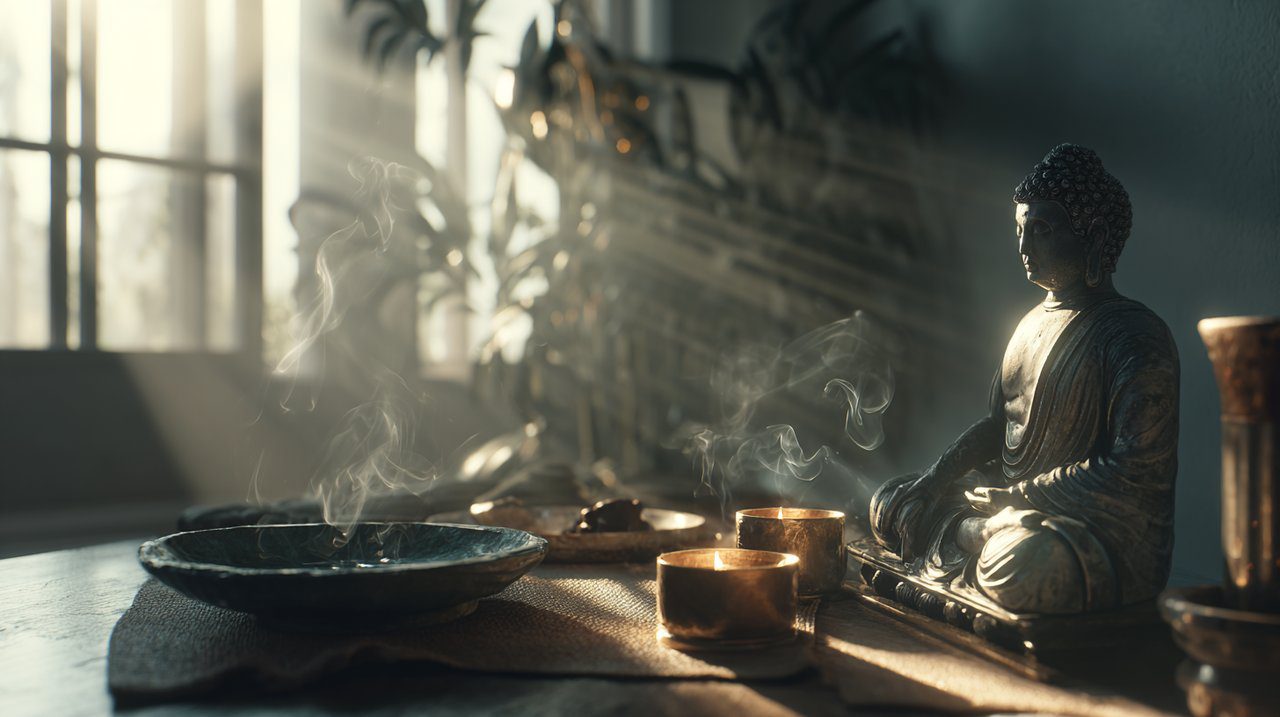Buddhist Shrine: The Ultimate Guide to Setting Up Your Sacred Space at Home
Just as a quiet stream gently navigates its way around stones, our human spirit often seeks a similar path of stillness amidst life’s constant currents. In our busy lives, the desire for a dedicated space—a small island of calm—is a common and natural one. It’s right here, within the comfort of our own homes, that we can create such a sanctuary: a personal Buddhist shrine.
The Sacred Echo: Understanding Your Home Shrine’s Purpose
The gentle rustle of leaves often carries a whisper of ancient wisdom. Similarly, even a simple home shrine holds a deep significance. It’s more than just a collection of beautiful objects; it becomes a focal point for our intentions, a space for reflection, and a guide for our spiritual practice.

More Than an Altar: What is a Buddhist shrine called?
While we often refer to it as an “altar,” a Buddhist shrine (or Buddha shrine) actually holds a broader meaning. Think of it as a specific, designated area—perhaps a small table or shelf—that you dedicate entirely to Buddhist practice and veneration. Its primary goal is to help you cultivate mindfulness and strengthen your connection to the teachings.
- Mandala: In certain traditions, the very arrangement of your shrine can be viewed as a symbolic mandala, representing the cosmos itself.
- Sacred Space: Ultimately, it’s a Buddhism shrine that beautifully transforms a part of your home into a sacred space at home.
Why a Sacred Space? The Call for Inner Peace
Just as a steadfast mountain anchors itself against changing skies, a personal shrine offers a stable point in your daily rhythm. It serves as a gentle, visual reminder of your spiritual aspirations and a quiet invitation to simply pause and be.
- Mindfulness: It gently encourages those precious moments of quiet contemplation and present awareness.
- Reflection: This space becomes a personal haven to reflect on the teachings and your unique spiritual journey.
- Connection: It provides a tangible link, connecting you to the broader Buddhist tradition and community.
Gathering Nature’s Gifts: Essential Elements for Your Shrine
Think of a thriving forest floor, where every element—a stone, a leaf, a dewdrop—contributes to a harmonious whole. Building your Buddhist shrine at home involves carefully selecting elements that truly resonate with spiritual meaning and your personal devotion.
The Core Offerings: Light, Water, Incense, and Sound
These fundamental elements are much like the sun, rain, and wind – simple in their form, yet deeply significant in their presence and symbolism.
- Light (Candles or Lamps): This represents wisdom, illuminating the darkness of ignorance. Even a single flame can profoundly transform the atmosphere of a room.
- Water (Fresh Water Bowl): Symbolizing purity, clarity, and the refreshing essence of the Dharma. Think of it like a clear, cool spring, cleansing and revitalizing.
- Incense (Sticks or Cones): It signifies the spread of virtue and gently reminds us of the ephemeral nature of all existence. Its fragrance beautifully underscores impermanence.
- Sound (Bell or Singing Bowl): Used to mark the beginning and end of meditation, it helps bring your mind to a state of focused attention. The resonance can be wonderfully calming.
Sacred Imagery: Choosing Your Buddha shrine Focus
The image on your Buddha shrine at home serves like a still lake reflecting the sky—a powerful point of focus for your contemplation. Whether it’s a statue or a thangka, its presence is a quiet invitation to connect.
- Buddha Statue: These often depict the historical Buddha in various postures, with each pose conveying specific qualities such as deep meditation or compassionate teaching.
- Bodhisattva Figures: These are images of enlightened beings who, out of immense compassion, choose to postpone their own nirvana to help all others find liberation.
- Thangkas (Scroll Paintings): These are intricately detailed scroll paintings that depict Buddhas, deities, or mandalas, rich with symbolic meaning.
Personal Touches: Integrating mala beads and healing crystals
Just as a bird meticulously gathers twigs for its nest, you can personalize your Buddhist home shrine with items that specifically support your practice and intention. Think of them as small, resonant stones collected during a quiet, meaningful walk.
- Mala beads: These are traditionally used for counting mantras during meditation, providing a tangible link to your focused intention.
- Healing crystals: While not strictly traditional in Buddhism, many practitioners find that certain crystals can enhance the meditative atmosphere, bringing specific energies like calm or clarity to their space.
The Flow of Stillness: Designing Your sacred space at home
The way a river flows gracefully around obstacles, always finding the path of least resistance, offers a wonderful lesson in arrangement. Designing your Buddhist home shrine is all about creating harmony and ease, allowing positive energy to flow freely.
Location, Location, Devotion: Finding the Right Spot
Just as a thriving tree needs stable ground and ample sunlight, your shrine will flourish in a thoughtfully chosen location. Consider a spot that naturally feels peaceful and allows for quiet reflection, a little removed from the immediate hustle and bustle of daily life.
- Quiet Corner: Look for a secluded spot in your living room, bedroom, or study—somewhere you can truly find peace.
- Cleanliness: It’s essential to always keep the area impeccably clean and free from clutter, reflecting a clear mind.
- Elevation: Ideally, place your shrine on a slightly elevated surface; this simple act signifies reverence and respect.
Arrangement Principles: Balance, Simplicity, and Intention
Much like a perfectly balanced stone cairn, a well-arranged shrine subtly speaks of inner order and calm. The key here is to create a visual harmony that actively supports your practice, rather than distracting from it.
- Centrality: Your main image, such as a Buddha statue, is typically positioned at the very center.
- Symmetry: Offerings are often arranged thoughtfully and symmetrically around this central image, creating balance.
- Clarity: It’s important to avoid overcrowding. Each item should have a clear purpose and its own dedicated space. A Buddhist shrine cabinet can be incredibly helpful in maintaining this sense of order.
Beyond the Basics: Considerations for a Zen space or meditation room ideas
Moving beyond just the altar itself, the surrounding environment can significantly amplify your shrine’s effect, much like a peaceful garden enhances the beauty of a single bloom. For those seeking deeper immersion, it’s worth considering the broader room as part of your sacred space.
- Minimalism: A Zen space truly emphasizes simplicity and uncluttered aesthetics, fostering a sense of calm.
- Comfort: A comfortable cushion or mat for sitting meditation will greatly enhance your practice and ability to focus.
- Natural Light: Where possible, incorporate natural light, or opt for gentle, warm lighting to create a soothing ambiance.

Cultivating Presence: Daily Rhythms and Your Shrine’s Living Spirit
The constant, gentle rhythm of the tides beautifully reminds us of how important consistent practice is. Your shrine isn’t just a static display; it’s a living space, nurtured and brought to life by your presence and intention.
Simple Rituals: Engaging with Your Shrine
Engaging with your Buddhist shrine home doesn’t need to involve elaborate ceremonies. Think of simple, heartfelt actions as being like watering a plant—they keep the spirit of your practice vibrant and alive.
- Daily Offerings: Simple acts like refreshing the water, lighting incense, or a candle.
- Short Meditations: Spending just a few minutes in quiet contemplation can make a big difference.
- Bowing: A humble gesture of reverence and respect towards the teachings.
Maintaining Harmony: Keeping Your Space Vibrant
Just as a diligent gardener tends to their plants, regular and mindful care for your home Buddha shrine ensures its continued vitality. Remember, cleanliness and order in your space often reflect a beautiful inner clarity.
- Dusting and Cleaning: Always keep all items and the surrounding area pristine and well-maintained.
- Fresh Flowers: If you choose to use them, remember to replace them as they wilt, maintaining freshness.
- Mindful Organization: Ensure that everything has its proper place, which in turn helps to reflect a peaceful and organized mind.
The Shrine as a Mirror: Reflecting Inner Growth
Over time, your Buddhist shrine will naturally become a mirror, beautifully reflecting your unique spiritual journey. Its enduring presence gently reminds you of the subtle shifts happening within, much like the gradual erosion of a stone by a steady stream, slowly revealing its true, beautiful form.
The Unseen Shrine: Extending Sacredness Beyond the Physical
While a physical shrine provides a wonderful anchor, the true Buddhist house shrine ultimately resides within you. Much like the wind, unseen yet felt everywhere, the spirit of your shrine can gracefully extend far beyond its physical boundaries.
Tibetan prayer wheels and Other Portable Practices
Just as a bird carries its unique song wherever it flies, certain practices allow you to carry the profound essence of your shrine with you, wherever you go.
- Tibetan prayer wheels: Spinning these, often inscribed with powerful mantras, is believed to generate merit and spread blessings widely.
- Portable Shrines: Consider small, foldable altars designed for travel or temporary setups, allowing you to create sacred space anywhere.
- Mindful Walking: This practice involves consciously carrying the peace and presence cultivated at your shrine into your everyday movements.
The Mind as the Ultimate Shrine
Ultimately, the most truly profound Buddha home shrine is the one you cultivate within your own mind. It is the spaciousness of your awareness, the unwavering calm of a clear intention, and the boundless compassion that naturally flows outward. This inner sanctuary is always accessible, always present, no matter where you are.
Creating a Buddhist shrine at home is a beautiful act of intention, a gentle dedication to cultivating genuine peace in your personal world. It marks a journey of bringing the stillness you create externally into your inner landscape, inviting a deeper, more authentic connection with yourself. As you thoughtfully set up your sacred space, you’re not merely arranging objects; you’re actively building a solid foundation for daily tranquility and profound spiritual growth, much like a steady rain gently nurtures the earth for a future bloom.
💡 よくある質問
A Buddhist shrine, often referred to as a home shrine or Buddha shrine, serves as a dedicated focal point for Buddhist practice and veneration. Its primary goal is to help cultivate mindfulness, strengthen one's connection to Buddhist teachings, and provide a space for reflection and spiritual practice within the home.
Key elements typically found in a Buddhist home shrine include: Light (candles or lamps) symbolizing wisdom, Water (a fresh water bowl) symbolizing purity and clarity, Incense symbolizing the spread of virtue and impermanence, and Sound (a bell or singing bowl) used to mark meditation and aid focus. Sacred imagery like a Buddha statue or thangka also serves as a focal point for contemplation.
The ideal location for a Buddhist shrine is a quiet, clean, and uncluttered spot, preferably on an elevated surface to signify reverence. Arrangement principles emphasize balance, simplicity, and intention, with the main image (like a Buddha statue) typically centered, and offerings arranged symmetrically around it to create visual harmony and avoid overcrowding.
Beyond the shrine, aspects like minimalism in decor, comfortable seating for meditation (like cushions or mats), and the presence of natural or gentle, warm lighting can significantly enhance the sacred space. The overall environment should foster a sense of calm and support contemplative practice.
Maintaining a Buddhist home shrine involves simple, consistent rituals such as daily offerings (refreshing water, lighting incense/candles), short meditations, and bowing as a gesture of reverence. Regular cleaning, replacing wilting flowers, and mindful organization keep the space vibrant and reflect inner clarity and peace.








